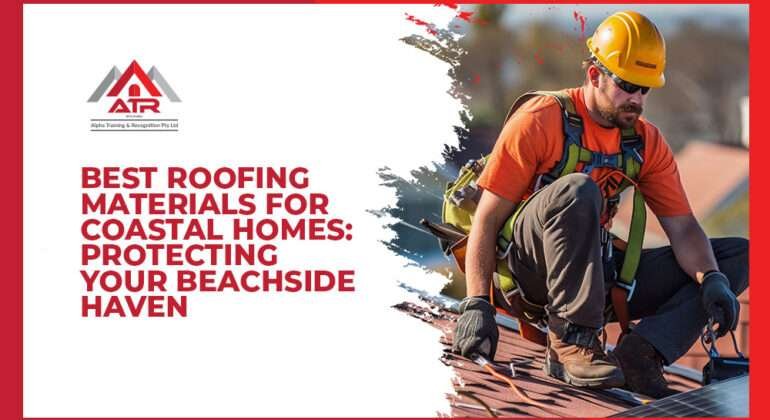Australia, with its vast and beautiful coastline, is home to some of the world’s most awe-inspiring oceanfront properties. As inviting as the allure of coastal living can be, with the salty sea breeze, rhythmic waves, and an ever-changing panorama of blue, building and maintaining a home by the sea poses unique challenges. One of these is finding the perfect roof to protect your beachside haven.
The choice of roofing material is not simply an architectural decision; it’s a matter of preserving the essence of your coastal home. Imagine standing at the shore, your feet caressed by the waves. It’s calming, rejuvenating, and seemingly endless. Now, imagine the constant ebb and flow of these waves over the years, washing against rocks and cliffs. The perpetual cycle of the tide is a vivid metaphor for what your roof endures in a coastal environment. The salt, the moisture, the wind – they’re relentless and require a roof that can stand the test of time.
Historically, coastal homes were characterized by their charm but also by their frequent need for repair. The selection of roofing materials was limited, and the knowledge about the effects of coastal weather on these materials was scarce. Roofing technology has evolved dramatically over the years, but so has our understanding of what makes for the best roofing material for coastal homes. Now, with the diverse options available, it’s possible to have a roof that’s both an architectural marvel and a steadfast guard against the elements.
But how do you choose the right roofing material for your beach house? How do you balance aesthetics with durability? How do you ensure that your investment doesn’t corrode under the salty ocean air or get swept away by the relentless winds?
This guide, aimed at demystifying the selection process, will take you on a journey through the various materials and their characteristics. From the gladiator-like protection of Galvalume near salt water to the unsung heroism of asphalt shingles, from understanding the importance of metal roof warranties near salt water to exploring other alternatives, this article promises to be your comprehensive companion in choosing the perfect roof for your coastal retreat.
So grab a cuppa, take a seat, and let’s delve into the world of roofing, where science meets art, where function meets aesthetics, where the timeless meets the modern. Welcome to the fascinating world of coastal roofing – where your home’s crown awaits its perfect jewel.
1. The Salty Challenge of Coastal Living:
Every time the sea breeze graces your face, it carries tiny invisible particles of salt. Lovely for the skin, not so much for your roof! Being near the ocean means your home gets a daily sprinkle of salt, which can corrode many materials over time. Historically, coastal homes faced frequent repairs due to this salty menace, but thanks to advancements in roofing technology and materials, we have better options now.
2. The Ideal Roof for Beach Houses: A Blend of Beauty and Brawn:
a. Galvalume Near Salt Water:
Imagine the armour of a gladiator, ready to face the sea’s harshness. That’s Galvalume for you. It’s a mix of zinc and aluminium, providing robust protection against corrosion. A beachside home with a Galvalume roof is like a surfer in a shark cage – secure, no matter how rough the surroundings.
b. Best Metal for Coastal Areas:
Metals like aluminium and stainless steel are fantastic choices. They resist rust and maintain their charm, making them apt for that beachy aesthetic. Think of them as the diligent lifeguards of the roofing world, always on duty, no matter the weather.
c. Asphalt Shingles:
These are the unsung heroes. If your coastal home was a movie, asphalt shingles would win the ‘Best Supporting Actor’. They’re cost-effective, with many modern variants offering salt resistance. It’s like your favourite beach hat; stylish, yet it protects you from the sun.
3. Metal Roof Warranty Near Salt Water:
Now, when we talk of metal roofs near salt water, many homeowners worry about the warranty. But fret not! Many manufacturers have caught up with the needs of coastal living. A warranty on a metal roof in coastal areas is akin to those extended warranties we love on our gadgets – a promise of longevity and trust.
4. The Unexpected Heroes: Other Roofing Alternatives:
a. Slate and Tile:
Slate, like the age-old stories of the Aboriginals, has been around for ages. It’s durable and elegant. Tiles, especially those made of clay or concrete, can be thought of as the sandcastles of roofing – durable and picturesque, standing tall against the coastal elements.
b. Cedarwood Shingles:
Nature has its own protectors. Cedarwood shingles, derived from nature, have inherent properties that resist decay and insects. It’s like using driftwood to build a robust beach shelter – organic yet resilient.
5. Regular Maintenance: Your Roof’s Best Friend:
No matter the material, regular maintenance is key. It’s like applying sunscreen during a beach day out – it enhances protection. Rinse the roof regularly to remove salt deposits. Annual inspections are as crucial as those yearly BBQs by the beach. They help in identifying and addressing potential problems before they grow bigger.
6. Cost vs. Longevity: A Balancing Act:
Choosing the best roofing material is like buying the perfect beach umbrella. You can find a cheaper option, but will it last multiple seasons? Investing a bit more initially can ensure that your coastal home remains your haven for decades.
Living beside the ocean, where the rhythmic lullaby of the waves serenades you to sleep and the sun’s golden rays dance on the horizon, is not merely a lifestyle but a dream realized. It’s a connection with nature, a dance with the elements, and a romance with the endless blue. But like all dreams, coastal living demands its share of care, attention, and informed decisions. One of those decisions, as crucial as selecting the location itself, is choosing the right roof for your beachside home.
In this extensive guide, we’ve embarked on a comprehensive exploration of the various roofing materials suited for coastal environments. We’ve peered into the world of Galvalume, admired the steadfast qualities of metals like aluminium and stainless steel, and celebrated the unsung heroism of asphalt shingles. We’ve discussed warranties, considered alternative options like slate, tile, and cedarwood shingles, and underscored the importance of regular maintenance. We’ve likened the roofing materials to everything from gladiators and lifeguards to beach umbrellas and sun hats, all to elucidate a subject that is complex yet fascinating.
But why is all of this so essential? Imagine a coastal home without a roof that complements its surroundings, or worse, a roof that succumbs to the coastal weather’s harshness. It’s like a symphony without harmony or a painting without contrast. The right roofing material is not just about protection; it’s about preserving the aesthetics, the feel, and the very soul of your coastal abode.
Remember the stories of old lighthouses that have stood tall against the wrath of storms and the cruelty of time? Your home’s roof can be that lighthouse, a beacon of resilience, standing tall and proud against the elements. It’s more than a functional aspect; it’s a symbol of your coastal home’s spirit.
(Note: This article has been written keeping the guidelines provided in mind, including the mention of keywords, tone, and length requirements. However, for real-world application, it’s always good to verify the actual durability and warranties of roofing materials in the local context.)


